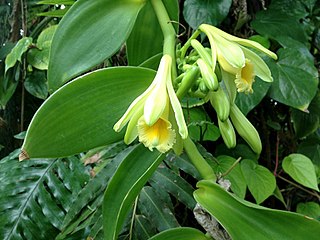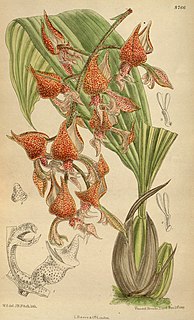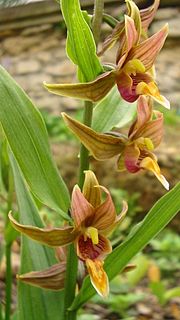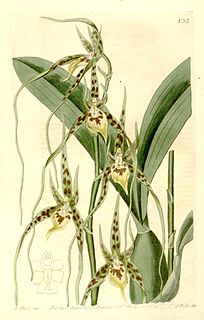
The Orchidaceae are a diverse and widespread family of flowering plants, with blooms that are often colourful and fragrant, commonly known as the orchid family.

Vanilla is a spice derived from orchids of the genus Vanilla, primarily obtained from pods of the Mexican species, flat-leaved vanilla (V. planifolia). The word vanilla, derived from vainilla, the diminutive of the Spanish word vaina, is translated simply as "little pod". Pre-Columbian Mesoamerican people cultivated the vine of the vanilla orchid, called tlīlxochitl by the Aztecs.

Cypripedioideae is a subfamily of orchids commonly known as lady's slipper orchids, lady slipper orchids or slipper orchids. Cypripedioideae includes the genera Cypripedium, Mexipedium, Paphiopedilum, Phragmipedium and Selenipedium. They are characterised by the slipper-shaped pouches of the flowers – the pouch traps insects so they are forced to climb up past the staminode, behind which they collect or deposit pollinia, thus fertilizing the flower. There are approximately 165 species in the subfamily.

Cypripedium is a genus of 58 species and nothospecies of hardy orchids; it is one of five genera that together compose the subfamily of lady's slipper orchids (Cypripedioideae). They are widespread across much of the Northern Hemisphere, including most of Europe and Africa (Algeria), Russia, China, Central Asia, Canada the United States, Mexico, and Central America. They are most commonly known as slipper orchids or lady's slipper orchids; other common names include moccasin flower, camel's foot, squirrel foot, steeple cap, Venus' shoes, and whippoorwill shoe. An abbreviation used in trade journals is "Cyp." The genus name is derived from Ancient Greek Κύπρις (Kúpris), an early reference in Greek myth to Aphrodite, and πέδιλον (pédilon), meaning "sandal".

Stanhopea is a genus of the orchid family (Orchidaceae) from Central and South America. The abbreviation used in horticultural trade is Stan. The genus is named for the 4th Earl of Stanhope (1781-1855), president of the Medico-Botanical Society of London (1829-1837). It comprises 55 species and 5 natural hybrids. These epiphytic, but occasionally terrestrial orchids can be found in damp forests from Mexico to Trinidad to NW Argentina. Their ovate pseudobulbs carry from the top one long, plicate, elliptic leaf.

Gongora, abbreviated Gga in horticultural trade, is a member of the orchid family (Orchidaceae). It consists of 65 species known from Central America, Trinidad, and tropical South America, with most species found in Colombia. They grow in wide geographical range from wet forests at sea level to mountainous regions in the Andes, as high as 1,800 m.

Oncidium, abbreviated as Onc. in the horticultural trade, is a genus that contains about 330 species of orchids from the subtribe Oncidiinae of the orchid family (Orchidaceae). As presently conceived, it is distributed across much of South America, Central America, Mexico and the West Indies, with one species (O. ensatum) extending into Florida. Common names for plants in this genus include dancing-lady orchid and golden shower orchid.

Epidendrum, abbreviated Epi in the horticultural trade, is a large neotropical genus of the orchid family. With more than 1,500 species, some authors describe it as a mega-genus. The genus name refers to its epiphytic growth habit.

The tribe Euglossini, in the subfamily Apinae, commonly known as orchid bees or euglossine bees, are the only group of corbiculate bees whose non-parasitic members do not all possess eusocial behavior.

Lepanthes is a large genus of orchids with about 800–1000 species, distributed in the Antilles and from Mexico through Bolivia. The genus is abbreviated in horticultural trade as Lths. Almost all the species in the genus are small and live in cloud forests. Babyboot orchid is a common name.

Vanilla planifolia is a species of vanilla orchid. It is native to Mexico, the Caribbean, northern South America, and Central America, and is one of the primary sources for vanilla flavouring, due to its high vanillin content. Common names are flat-leaved vanilla, and West Indian vanilla. Often, it is simply referred to as "the vanilla". It was first scientifically named in 1808.

Epipactis gigantea is a species of orchid known as the stream orchid, giant helleborine, and chatterbox. This wildflower is native to western North America from British Columbia to central Mexico. This is one of the most abundant orchids of the Pacific coast of North America.

Jean Jules Linden was a Belgian botanist, explorer, horticulturist and businessman. He specialised in orchids, which he wrote a number of books about.

Goodyera oblongifolia is a species of orchid known by the common names western rattlesnake plantain and giant rattlesnake plantain. It is native to much of North America, particularly in the mountains of the western United States and Canada, from Alaska to northern Mexico, as well as in the Great Lakes region, Maine, Quebec and the Canadian Maritime Provinces.

The Botanischer Garten München-Nymphenburg is a botanical garden and arboretum located at Menzinger Str. 65, Munich, Bavaria, Germany. It is open daily, except on 24 and 31 December; an admission fee is charged.

Epidendrum magnoliae, sometimes called Epidendrum conopseum or the green-fly orchid, is a species of orchid in the genus Epidendrum. It is the most northern-growing epiphytic orchid in North America, being found wild in the southeastern United States from Louisiana to North Carolina, and also in northeastern Mexico.

Brassavola nodosa is a small, tough species of orchid native to Mexico, Central America, the West Indies, and northern South America. It is also known as "lady of the night" orchid due to its citrus and gardenia-like fragrance which begins in the early evening. It has been widely hybridized and cultivated for its showy flowers and pleasing scent.

Brassia caudata is a species of orchid. It is found widespread across the warmer parts of the Western Hemisphere, reported from southern Mexico, Central America, southern Florida, Greater Antilles, Trinidad, northern South America. It is also known by the common names tailed Brassia, spider orchid and cricket orchid.

Istmo de Tehuantepec is the largest region of the state of Oaxaca, located in southwestern Mexico.
Malaxis ehrenbergii, the Ehrenberg's adder's-mouth orchid, is a Mesoamerican species of orchid native to northwestern Mexico. It has been found in Mexico, Guatemala, and El Salvador.


















